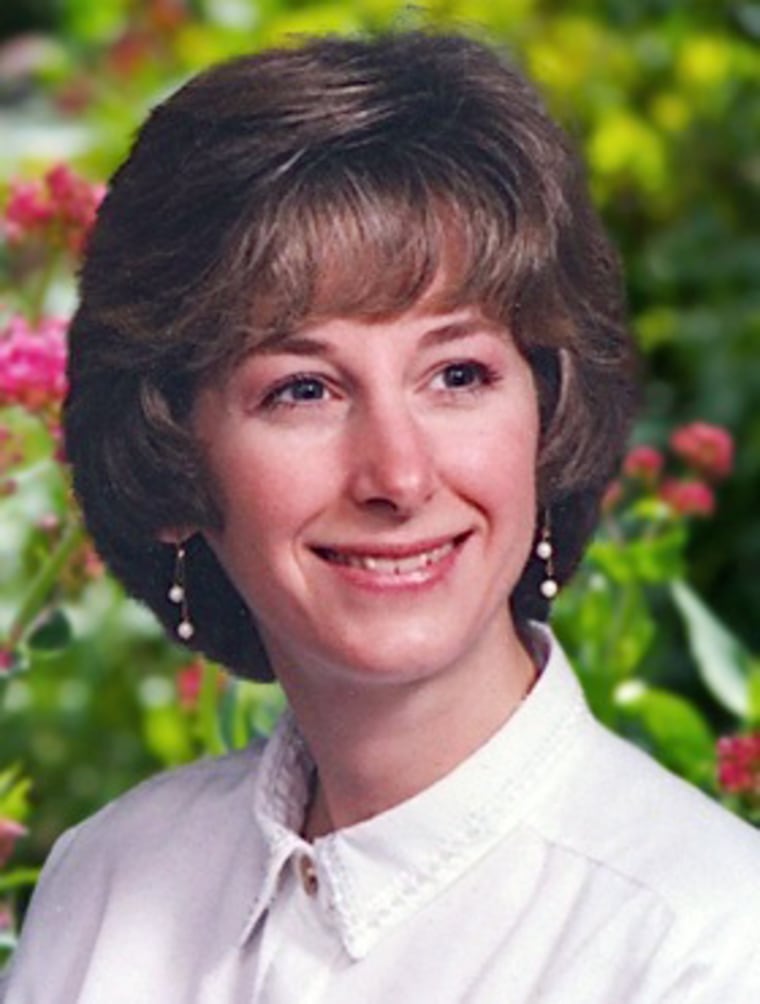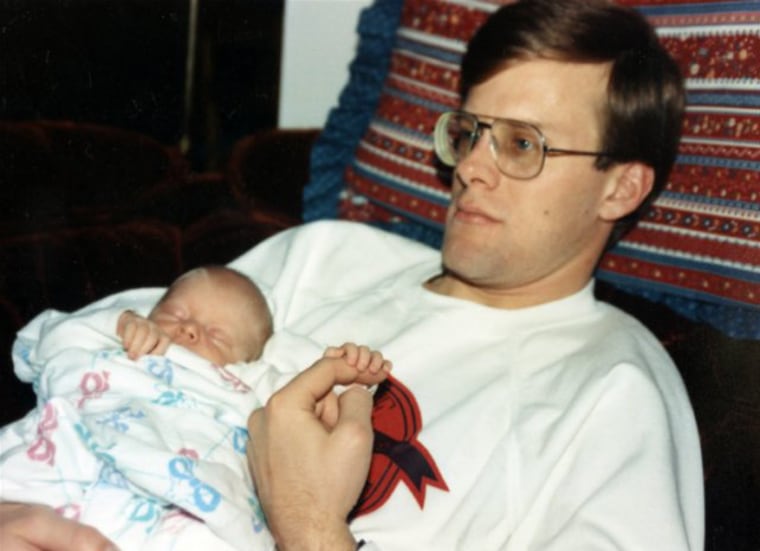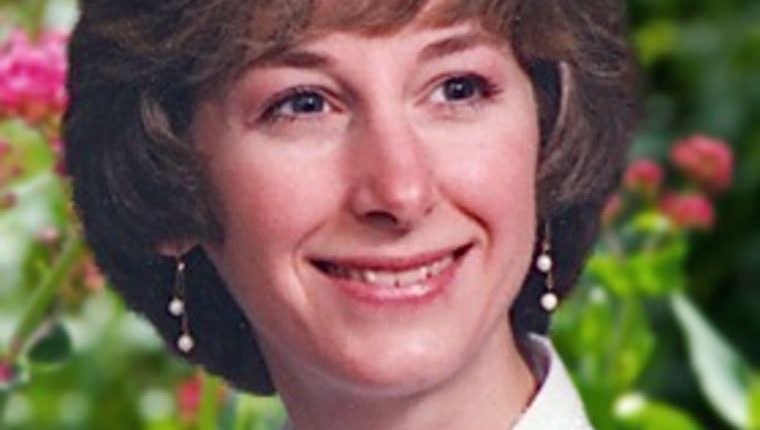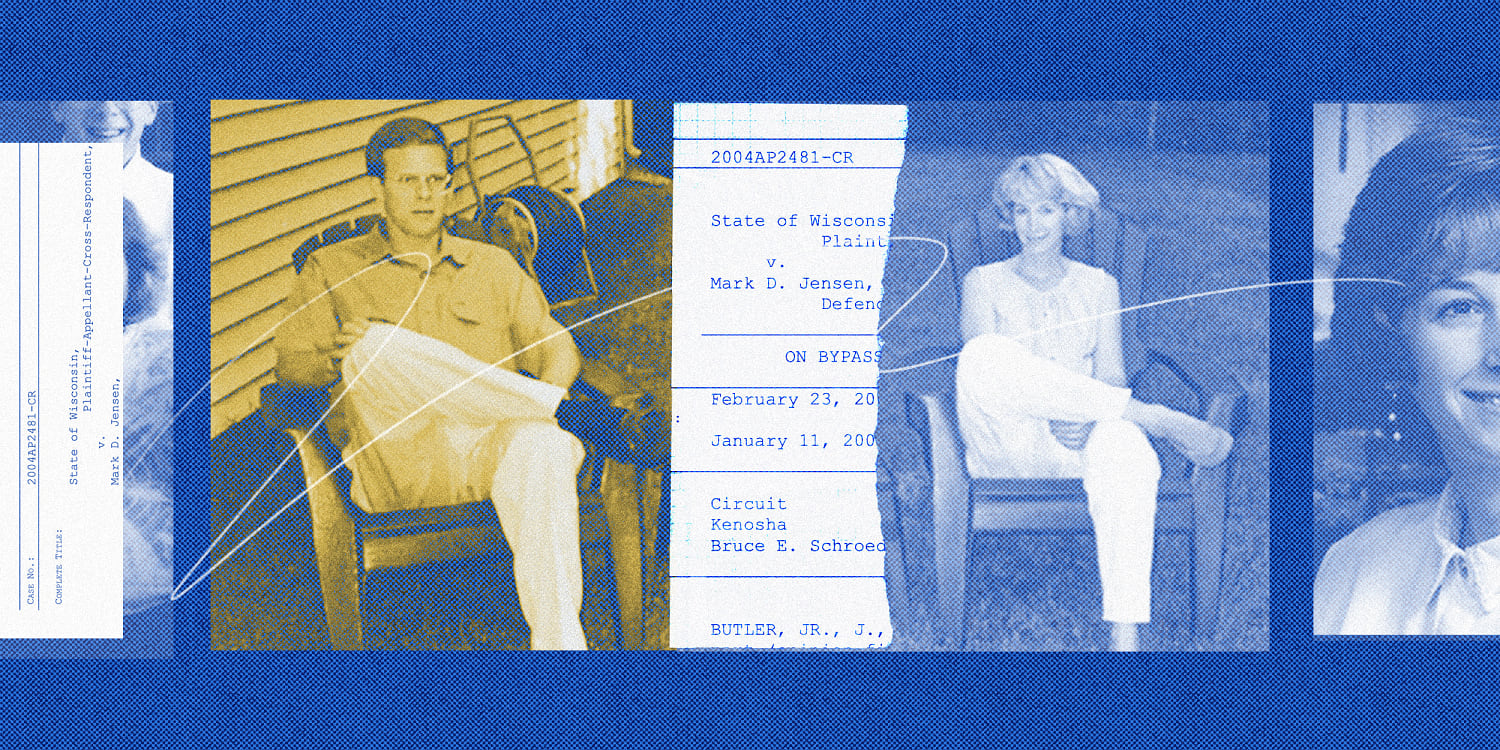Julie Jensen was found dead in her Wisconsin bedroom nearly 25 years ago, her body poisoned by the primary ingredient in antifreeze, ethylene glycol.
The effort to prosecute Jensen’s killer — her husband of 14 years — took almost as long, with protracted court battles over a key piece of evidence, two trials and one overturned conviction.
Earlier this year, Mark Jensen was sentenced — again — to life in prison in the killing.
Here are four key moments from the legal saga, as told by the prosecutors.
For more on Julie Jensen’s death, watch “Secrets in Pleasant Prairie” on “Dateline” at 10 ET/9 CT tonight.
Dec. 3, 1998: Julie Jensen is found dead
Mark Jensen, 63, called 911 and said he’d discovered the body of his 40-year-old wife at their home in Pleasant Prairie, Wisconsin, just south of Kenosha. She was in bed, under the covers, wearing a T-shirt and underwear. She had no obvious injuries, Bob Jambois, then the Kenosha County district attorney, told NBC’s “Dateline.”
A deputy medical examiner at the scene initially believed the death was due to natural causes, Jambois said. But to the county’s top prosecutor, a series of suspicious details stood out: Julie’s position on the bed seemed unnatural — she appeared to have been rolled onto her side — and even though she was so sick she’d complained of breathing problems, her husband had left her alone that day.
A detective briefed Jambois on another startling detail: Julie had been targeted for years by an anonymous stalker, with hang-up phone calls and a barrage of pornographic photos.
She believed the culprit might be a man with whom she’d had a brief affair, Jambois said. Authorities had their own suspicions about who was behind the harassment, but it would be years before they offered proof in a courtroom.
In the meantime, Jambois learned of another clue that would become an essential part of the case he was building — a letter from Julie that seemed to predict her own death.
She addressed the note to the local police department and included a photo of an ominous list she had found in her husband’s planner. She told a prosecutor that she was afraid her husband was using the list to chronicle her behavior to make it look like she was losing her mind, the prosecutor, Angelina Gabriele, told “Dateline.”
Then, in late November, days before Julie was found dead, she placed everything inside an envelope and gave it to a neighbor. According to a photo of the note obtained by “Dateline,” she said her husband was acting suspiciously and she feared her “early demise.”
“If anything happens to me, he would be my first suspect,” she wrote, adding that she prayed she was wrong but he’d never forgiven her for the affair.

“I would never take my life because of my kids — they are everything to me!” she wrote.
When a detective confronted Mark with the letter the following April, asking why his wife would have written it, Mark said she was “off the wall” and he was concerned she would harm herself, according to a transcript of the interview obtained by “Dateline.”
“How did she stop breathing, Mark?” a detective asked at one point.
“I don’t know,” Mark responded. “I honestly don’t know.”
March 19, 2002: Mark Jensen charged with first-degree intentional homicide
The charge had taken years to file, Jambois said, because he hadn’t been able to rule out suicide as a possible manner of death.
Because of the small amount of ethylene glycol in Julie’s system, it had taken months for investigators to even find it, and Jambois said he learned that most poisonings linked to the chemical are suicide.
And though Julie said that she’d never take her own life, two days before her death she’d been prescribed antidepressants after telling a therapist she was miserable over her failing marriage, he said.
“I never for a moment thought Julie Jensen committed suicide,” Jambois said. “But what I did know is that the defense would be that she committed suicide.”
The medical examiner eventually determined her death to be a homicide and pointed to two causes — ethylene glycol poisoning and asphyxiation. Based on the testimony of a jailhouse informant who said that Mark had confided in him, prosecutors said that Mark panicked when the doses of ethylene glycol didn’t end Julie’s life.

As her breathing appeared to improve, Jambois said, Mark rolled her over and shoved her face into a pillow.
Prosecutors argued that another piece of evidence corroborated their theory that she had been poisoned. At 9:42 a.m. on the morning of Julie’s death, someone searched the internet on the family’s desktop computer for diminished consciousness from ethylene glycol poisoning, Jambois said. The two searches were then deleted.
During his interview with police, Mark said that his wife was so sick the morning of her death that she hadn’t been able to get out of bed.
“She couldn’t move. She could not even think straight,” Gabriele said. “She’s not on the computer tracking her own symptoms of ethylene glycol poisoning.”
Prosecutors also had the letter, though it wasn’t clear if they would be able to use it in court: In criminal cases, the Sixth Amendment guarantees the right of the accused to confront their accusers. In this case, the witness wasn’t available; she was dead.
Gabriele thought the letter might do more harm than good — and could present grounds for an appeal. But to Jambois, it was a critical piece of evidence that would allow jurors to hear Julie’s voice.
In the end, a judge allowed the document in — and it became the center of a legal battle that lasted more than a decade.
Dec. 18, 2013: Federal judge overturns conviction
The decision from a U.S. District judge in Wisconsin’s Eastern District came nearly six years after a six-week trial and more than 30 hours of deliberation, after which a jury found Mark guilty in his wife’s murder and a judge later sentenced him to life in prison.
In addition to the informant, the letter and the computer searches, prosecutors had amassed other evidence, including testimony from a former colleague of Mark’s who recalled a chilling conversation from roughly a month before Julie’s death.
While he and Mark were chatting and having a few drinks after a conference in St. Louis, Mark confided that you could poison your spouse with Benadryl, pool chemicals or ethylene glycol, the friend, Ed Klug, told “Dateline.”
But to federal Judge William Griesbach, the effect of the letter — which he described as the prosecution’s “roadmap” for trial — outweighed all of it, according to the 2013 decision ordering Mark’s release in 90 days if prosecutors failed to retry him.
And despite a lengthy hearing on the letter prior to that trial, as well as several state court decisions — including from Wisconsin’s high court — in Griesbach’s view, the document shouldn’t have been admissible. It violated Mark’s constitutional rights and had a “substantial and injurious” effect on the jury’s verdict, he wrote.
The decision stunned Gabriele.
“It was a punch in the gut to know that there was so much evidence of his guilt and that a jury spent three and a half days carefully considering all of it and carefully considering the law, and they came back with the guilty verdict, and that we had done everything the way we were supposed to do it,” she said, noting that prosecutors had followed a decision handed down by the Wisconsin Supreme Court.
“And then to have the federal court tell us, no, do it again was just like — I just wanted to throw up,” she said.
But there was no question they would aim for another conviction, Jambois said.
“I could have been gumming my oatmeal in the old folks’ home,” he said. “I’d have climbed out of my wheelchair and crawled back into court to try this case again.”
Feb. 1, 2023: Mark Jensen is convicted — again
After years of delays, Mark’s second trial began on Jan. 9. This time, prosecutors didn’t offer Julie’s letter as evidence. But with the help of a Department of Justice computer analyst, they’d uncovered something else — evidence that Mark was the person who’d been harassing Julie for years.
On an external computer drive, they found a fake email laden with pornographic attachments that Mark had sent himself, only he’d tweaked the name of the sender to make it seem as if it had been sent by someone else, said Carli McNeill, the deputy district attorney who prosecuted the case.
Then Mark presented the email to his wife as evidence of harassment, and she noted it in a catalog of the disturbing events, McNeill said.
But to McNeill, the most damning evidence was something they’d had since the beginning — the computer searches from the morning of Julie’s death.
And when a jury delivered a guilty verdict nearly a month later, Jambois said he felt far more confident than he did the first time around, when the legal issues surrounding the letter loomed over the trial.
“This was a clean trial,” he said. “I’m absolutely confident this case is going to withstand appellate review.”
Source: | This article originally belongs to Nbcnews.com










